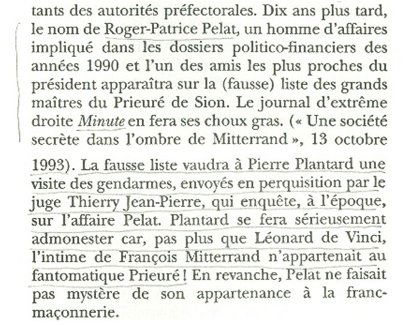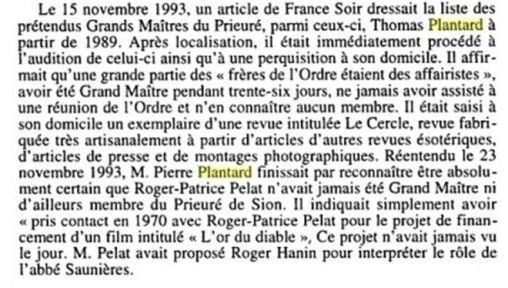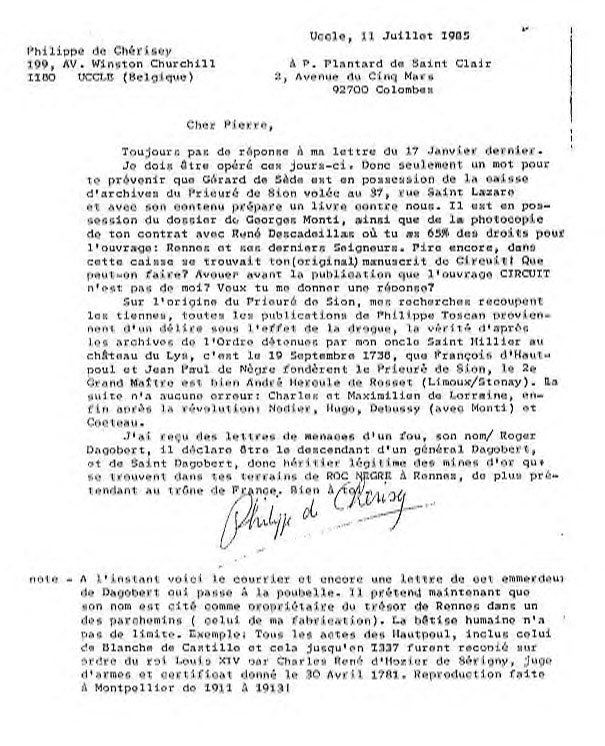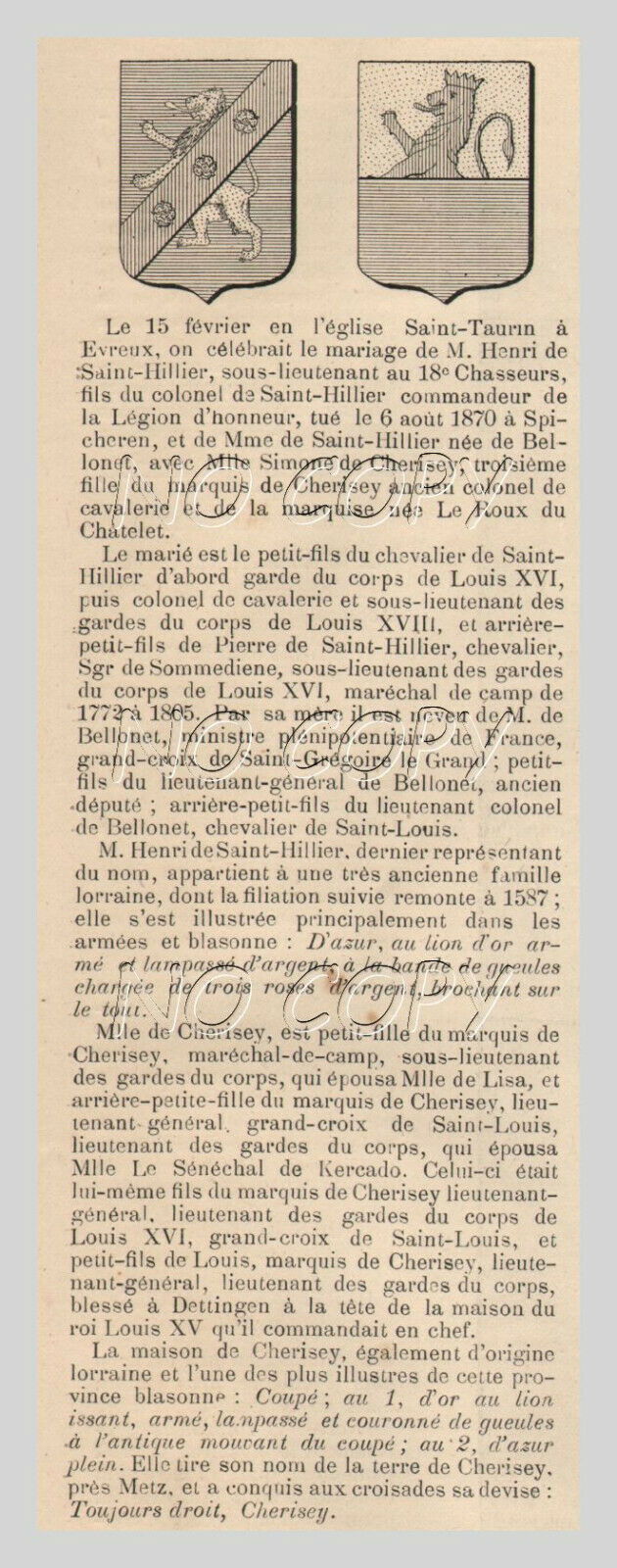If the judge had said that the letter sent by René-Roger Dagobert was false, why did the press accuse Plantard of the fabrication?
It is very noticeable that interest in the Affair of the Two Rennes has waned significantly over the last few years - unless of course you happen to be writing banal fiction for the hungry masses who love a good conspiracy theory. Then you will be met with the Da Vinci Code furore and all the associated mayhem that came with it!
Most researchers though, seem to have gone to ground or at the very least are participating on private forums. Has this total interest dissipated after years of relentless insults thrown at individuals if you accepted a particular theory or not?
I recently came across a very interesting piece by an Italian writer called Angelo Cipriani who expressed the same opinion. I quote here from his site [my translation]:
"The sites and forums on Rennes-le-Chateau are today much less frequented than in the past and this decline, this noticeable decrease in attention, is not only in Italy but also foreign sites. This declining interest in the subject, this sudden "decline of desire", seems to be the result of a tiring of, as well as a useless digression on some points, of the story and the consequent unleashing of many controversies, in particular in regard to the "falsity" - true or presumed - of the two parchments as they appeared in the old book by Gerard de Sede (L'or de Rennes).
Too much insistence was given on the part of some Italian and foreign researchers (Tomatis, Jannaccone, Introvigne, Smith, etc.) in attempting to demonstrate, at all costs, the unreliability of the contents and/or the material falsity of the parchments and, with this, an attempt was made to definitively close the story, turning off the spotlight on it, reducing it all to a skilful mystification (the French say intoxication) hatched by Plantard, Cherisey and their fellow followers in the Priory of Sion.
The two acclaimed findings of a few years ago are undoubtedly help the going in this direction: the first is the book from which the text used in the first parchment was copied, the Codex Bezae which was reproduced in the "Dictionnaire de la Bible" Tome 1: AB Editor: F.Vigouroux, Paris, 1895 "; and the second, concerns the text of the second parchment, allegedly taken from the book by John Wordsworth and Henry Julian White (ed.), Novum Testamentum Latine Secundum Editionem Sancti Hieronymi, Oxford (I ed. 1889, & 1950 edition). The last blow was inflicted by the publication of the book "Pierre et Papier", which came from the pen of the ineffable Marquis de Cherisey and given, posthumously, to the press by his faithful disciple Jean-Luc-Chaumeil who, with this publication, seems to want to sanction the definitive "falsity" of the parchments.
Furthermore, we must also consider the constant hammering .... made by many, with a clear disparaging purpose, on unpleasant events - including judicial ones - relating to the private life of Plantard, & in particular the Pelet affair ... as an example of admission of all the falsehoods that have been accomplished".
If i have ever come across anything to justify the translation of all documents to help the English better understand the Affair, this is it. According to Angelo Cipriani [in regards to the Pelet Affair, the Press and the report published by the Judge presiding over the affair] he quotes the following;
"The direct reading of the passages of the text of the investigation drawn up by the investigating judge concerning Plantard [in the Pelet Affair] clarifies instead that it was not Plantard who wanted to present himself to the judge of his own free will - as claimed by some - but who was summoned after the complaint presented by one of his "competitors" (René-Roger Dagobert). Following a search carried out at the home of Pierre Plantard's son Thomas, who was also heard by the judge as Grand Master of the Priory, and after the acquisition of a libretto ("un examplaire d'une revue titulée "Le Cercle"), Plantard made it very clear that Patrice Pelat had never been Grand Master of the Prieure de Sion. In reality, all this, it seems to me, was an attempt to "re-veil" - that is, to spread a new veil - on the mystery of Rennes, [and] in fact it almost seems to want people to say: if everything is false it is useless to waste time on it!".
Angelo Cipriani then highlights various texts from the court case which casts a different light on the Pelet Affair in regards to Pierre Plantard.
"The only novelty - which raised attention for a while on the story - is "The Da Vinci Code" which has partly taken up, and expanded on the basic theme of the Rennes affair, and the subsequent stir that it caused [became responsible] for the .... infinite number of criticisms and, obviously, also the old controversy for and against Plantard, the Priory of Sion, etc. I refer, in particular, to Mme Marie -France Etchegoin - reporter at the Nouvel Observateur.The charming lady wrote a book with Frédéric Lenoire with a harsh note about Plantard:

and the press in another article, again by the Nouvel Observateur (9.6.2010).

On the basis of these reports, many people in Italy and abroad concluded that Plantard had retracted everything. But the judge, as we have just reported above, had written quite another thing:

A rough translation is as follows: "On November 15, 1993, an article in France Soir listed the alleged Grand Masters of the Priory, among these, [was] Thomas Plantard - from 1989. After localisation, a search was immediately proceeded to of his home. He affirmed that a large part of the "brothers of the Order were business people", and after having been Grand Master for thirty-six days, he had not attended any meeting of the Order and did not know any members. It was seized at his home a copy of a magazine entitled Le Cercle, a revue made up of handcrafted various articles of other esoteric journals, press articles and photo montages. Heard again on the 23rd November 1993, Mr. Pierre Plantard finally admitted to being absolute - it is certain that Roger-Patrice Pelat had never been Grand Master or member of the Priory of Sion. He simply indicated that "he made contact in 1970 with Roger-Patrice Pelat for the financing of a project - a film entitled "The devil's gold". This project had never seen the day. Mr. Pelat had proposed Roger Hanin to play the role ofabbé Saunières".
On the basis of Plantard's statements, Cipriani continues - the judge concluded very differently from what was reported in the press. And here, in fact, is the grand finale:

"There was therefore every reason to think that the letter by M. Dagobert on the letterhead of the Priory on the death of Roger-Patrice Pelat was a fake/forgery".
A newspaper, Le Point [Le Point is a French weekly political and news magazine published in Paris. It has a conservative, centre-right stance without any political affiliation] also published the following;
"One therefore only can think that the letter delivered by M. Dagobert made on the Priory's headed paper relating to the death of Patrice Pelat was a forgery" and, therefore, if there had been a forgery it had certainly not been committed by Plantard (Affaire Pelat - Le rapport secret. LE POINT, numéro 1112, 8 janvier 1994, p. 11).
Cipriani continues; And so, if the judge had said that the letter sent by R. Dagobert was false, why did the press accuse Plantard of the whole fabrication?
It is not my intention here to become M. Plantard's sword defender, but only of the truth, yes!
After this, however, others take to the field (CESNUR, CICAP, OPUS DEI) and a great silence fell again on Rennes".
[You can find the original Cipriani text HERE].
Up to reading this I was not aware the Roger-Rene Dagobert had sent a letter to the Judge in the Pelat Affair! This same Roger had also had prior 'beef' with Plantard and Cherisey and the Priory! This concerns an alleged letter written by Cherisey to Plantard in reference to some stolen files, and in it he mentions Roger-Rene Dagobert. Here is the whole story, starting with information supplied by Henry Lincoln when he met Plantard for the full background context:
"In an extract from 'The Key to the Sacred Pattern' by Henry Lincoln he described a meeting with Philippe de Cherisey. (pp154)
"The day is ending, but it is fine. De Cherisey expresses a desire to take a stroll and a lengthy preambulation end on a bench in the Tuileries Gardens. He is still regaling me with well told - and often very funny - anecdotes. But I have more on my mind than entertainment. We are getting on well and the atmosphere is friendly. At last, with time passing and nothing to lose, I decide to put my request baldly.
'Can I take another look at the parchment photographs?'
With only minimal hesitation, he opens his briefcase and hands them to me.
'Why add the marks' I ask
'To amuse the laity' he replied
'But why?' I insist.
He shrugs 'I'm an entertainer.'
It is clear that I am to get no straight answers. But - perhaps simply because it was to hand - he adds another fragment. Picking a few sheets from his case, he says: 'I'm writing an explanation of the codes. I'll send you a copy. You'll be amused'. But I am never to see it. Nor am I ever to get any closer to the 'parchment originals'. Sadly Philippe de Cherisey died suddenly in July 1985."
An added footnote is explained as follows:
1] There is reason to suspect that this document may have been part of the haul of stolen Priory papers' which figured in the Chaumeil imbroglio.
These documents may be the ones that figure in a book by Chaumeil over 20 years later and which carries a copy of a document called Stone & Paper - which is Cherisey's explanation of the codes in his own handwriting of the Sauniere parchments.
What suggestion is Lincoln making here? That a document of Cherisey - stolen - might have something either to do with Chaumeil or which got into Chaumeil's hands?
There is a reference to stolen files is in a purported letter typed by Cherisey himself to Plantard - saying that;
"Still no answer to my letter of the 17th January ... Thus only one word to warn you that Gerard de Sède is in possession of the case of files of the Priory of Sion stolen from 37, rue Saint Lazare and with it's contents he is preparing a book against us. He is also in possession of the file of George Monti, as well as a photocopy of your contract with Rene Descadeillas re: your 65% of the rights for the work: Rennes and its last Lords. Worse still, in this case was your (original) manuscript of Circuit! What can one make of the affair? Before publication - do you want me to say CIRCUIT isn't by me? What answer do you want me to give?
On the origin of the Priory of Sion, my research ...... [shows?] all the publications of Philippe Toscan come from one [who] is delirious under the effect of drugs ...... the truth according to the files of the Order held by my uncle Saint Hillier at the Chateau de Lys, is that on September 19, 1736, François d' Hautpoul and Jean Paul de Negre founders of the Priory of Sion, the 2nd Grand Maitre is Andre Hercules de Rosset (Limoux/Stenay). The continuation does not have any error: Charles and Maximilien of Lorraine, finally after the revolution; Nodier, Hugo, Debussy (with Monti) and Cocteau.
I [also] received a threatening letter from an insane [madman], his name is Roger Dagobert, he declares [to be] the descendant of general Dagobert, and Saint Dagobert, therefore heir legitimate to the gold mines that are on your grounds at ROCK NEGRE at Rennes, and moreover, that he is pretender to the throne of France. Soon" .
As you can read, Cherisey adds a note about Roger Rene Dagobert suggesting that this Dagobert claimed to be 'proprietor of the Treasure of Rennes as cited in the parchments'.
The alleged letter is reproduced below:

Above - the letter of Cherisey to Plantard ..Just as a point of interest - the date of the letter looks to be 11th July 1985. If this is correct 6 days later Cherisey was dead. But one does have to be cautious - after all, how do we know if this letter is genuine? As some have pointed out, Cherisey was not known for his typewritten letters!
I may also add that Cherisey does indeed have links with a Hillier - they are an ancient noble family from Lorraine [as was Cherisey] and are detailed below:

And the Chateau du Lys would appear to be this one - owned by Colonel Henri Marie Lucien de Saint-Hillier,of Château du Lys in Bressolles, and he married Simone de Cherisey on 14 february 1890. Simone's father was Frédéric Louis Victor de CHÉRISEY - who married Berthe Le ROUX du CHATELET and had several children including Gérard de CHÉRISEY [1863-1947] who himself married Marguerite NOËL du PAYRAT. Their children included Francois Henri Marie Louis Marquis de Cherisey who is of course father of one Philippe Louis Henri Marie Marquis de Cherisey, b. 13 Feb 1923, Paris and who 17 Jul 1985, Paris France.
